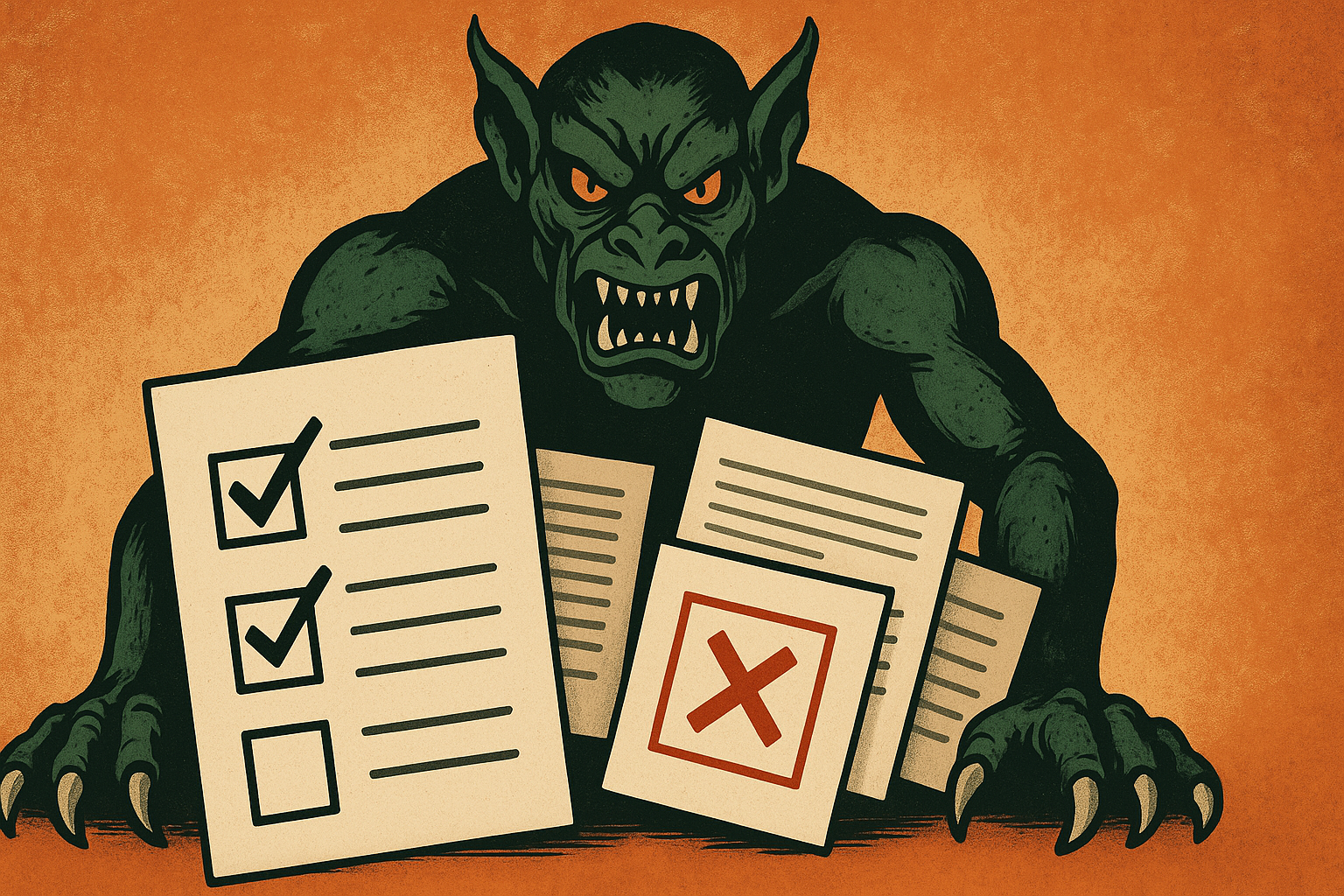
Analyzing the US Rejection Office
Given the USPTO’s pro-rejection tendencies introduced in Part 1 of this series, one might expect the agency would function like a well-oiled machine to properly reject claims in a smooth and efficient fashion. MPEP guidance on how to examine and reject claims is extensive, straightforward and reasonable. Examples include:
MPEP 706 “The goal of examination is to clearly articulate any rejection early in the prosecution process so that the applicant has the opportunity to provide evidence of patentability and otherwise reply completely at the earliest opportunity.”
MPEP 707.02 “The supervisory patent examiners should impress upon their assistants that the shortest path to the final disposition of an application is by finding the best references on the first search and carefully applying them.”
MPEP 707.07(f) “In order to provide a complete application file history and to enhance the clarity of the prosecution history record, an examiner must provide clear explanations of all actions taken by the examiner during prosecution of an application.”
MPEP 2103(I) “Examiners should state all reasons and bases for rejecting claims in the first Office action. Deficiencies should be explained clearly, particularly when they serve as a basis for a rejection.”
In 2023, the USPTO churned out 477,639 office actions, the majority of which contained rejections. Practice should make perfect. OPQA has found otherwise. Across the technology centers and across the various statutes, claim rejections do not comply with MPEP guidance.
Checking the technical accuracy of an invention and prior art is an important part of formulating a proper rejection under 35 U.S.C. 102 or 103. OPQA found that 98.2% and 97.5% of all Office actions fail to include a detailed technical analysis with regards to the invention and/or applicability of the prior art in an anticipation or obviousness rejection, respectively.
A detailed analysis of the claims involves the examiner’s explanation of how they are interpreting the claim/term/phrase for the purposes of the rejection. This was not done in 75.5%, 89.8%, and 91.8% of the rejections under 35 U.S.C. 101, 102 and 103, respectively. When examiners do provide a claim interpretation, OPQA found it wrong and identified this error as the root cause for
- 12% of the improper anticipation rejections,
- 8% of the improper obviousness rejections,
- 13% of the improper written description rejections,
- 16% of the improper enablement rejections, and
- 26% of the improper 101 subject matter eligibility rejections.
Statements of patentable weight pertaining to the importance or criticality of a specific element or feature were missing from 93.5% and 96.5% of all OPQA-surveyed 102 and 103 rejections.
For limitations which invoke 35 U.S.C. 112(f), 99.8% and 99.6% of the improper 102 and 103 rejections failed to explain how the prior art structure was the same or equivalent to the corresponding structure.
No articulated reason or rationale was present in 67.9% of the improper 103 rejections.
Based on OPQA findings of all surveyed rejections, in 2024, examiners failed to include a detailed legal analysis of applicable legal issues through a detailed analysis of the claims and the case law/policy that applies thereto in
- 99.1% of the 102 rejections
- 97.2% of the 103 rejections
- 82.5% of the 112(a) enablement rejections
- 91.2% of the 112(a) written description rejections and
- 83.7% of the 101 subject matter eligibility rejections
Closely following the MPEP’s process for properly analyzing the claims and prior art in view of technical and legal considerations would (i) weed out low-quality rejections, (ii) beef up legitimate rejections and (iii) drive examination towards a quicker allowance or appeal.
Low Quality Rejections Become Sticky Rejections
Low quality rejections prematurely and improperly shift the burden to applicant, who must then guess how to address the examiner’s unstated or mis-stated technical and legal positions. Patent applicants may cancel a claim, amend a claim, and/or submit arguments intended to overcome the rejection, as they best understand it. OPQA found that arguments, which often supported by evidence, legal arguments, declarations and/or affidavits, are filed in advance of 98.1% of all final Office actions.
How should the examining corps address these carefully drafted responses replete with cogent analysis, technical explanations, policy guidance, evidence, and legal arguments?
MPEP 706 states “[t]he examiner then reviews all the evidence, including arguments and evidence responsive to any rejection, before issuing the next Office action.”
MPEP 707.07(f) provides “[w]here the applicant traverses any rejection, the examiner should, if they repeat the rejection, take note of the applicant’s argument and answer the substance of it.”
MPEP 2103(I) cautions that “A failure to follow this approach [of compact prosecution] can lead to unnecessary delays in the prosecution of the application.”
OPQA determined that patent examiners failed to acknowledge all submission of evidence (e.g., affidavits) and provide explanations directed to why the evidence was not found persuasive in 99.2% of all 6,555 surveyed Office actions. In 94.9% of all surveyed Office actions, examiners failed to cite pertinent arguments made by applicants that were persuasive in overcoming a previous rejection.
In May 2025, the Government of Accountability’s reported “USPTO officials say that applicants are satisfied with the level of patent quality” despite being unable to explain why OPQA identified errors are so much lower that the PTAB invalidation rate. While some deep in the trenches may consider the widespread pattern of cursory review, shotgun-rejections as “good enough for government work,” it’s not good enough for protecting and promoting America’s IP system.
Clearly, MPEP guidance is overwhelmingly ignored. Low quality rejections are maintained and made final. This behavior led to 134,461 Requests for Continued Examination in FY2024. If MPEP instructions do not drive examiner behavior, what does?
Part 3 uncovers how quality element of the patent examiners PAP, which arose from an anti-innovation culture, encourages rejections over allowances.
Julie Burke has a PhD in Biochemistry from the University of London College of Science, Technology, and Medicine and a BA in Cellular and Molecular Biology from Johns Hopkins University. As a registered patent agent with 20 years'of experience at the patent office, Julie founded her own consulting company, IP Quality Pro LLC. She helps patent attorneys navigate complex situations in the patent system to protect the inventors' ideas. She is an advisor for Petition.ai, the first searchable database of US patent prosecution petitions and associated documents.
She serves as an expert witness in court on patent office procedures and practices and is frequently invited to speak on patent office issues at bar association conferences.







I have written about my experience with a USPTO examiner before.
Patent Examiner Jeremiah R Smith of Art Unit 1723 decided that a person of ordinary skill in the art would definitely have been able to anticipate my invention by reading the specification of my application in which I identified a compound used in my invention, and by reading previously granted patents which did not specify, nor identify nor infer the use of this compound, but relied on a natural product that contained the compound in the form of an UNRECOGNIZED IMPURITY.
The examiner insisted that the person of ordinary skill would be able to verify the examiner’s assumption by reading an online Encyclopaedia Britannica publication that was published AFTER my patent application was filed and published. The person would deduce that the identity of the compound I had relied on to practice my invention was known, despite not having been previously identified, nor recognized nor understood, and that my invention is anticipated.
The examiner ignored the fact that the person of ordinary skill in the art would be obliged to demonstrate an example of a prior art document describing the isolating of the compound from the prior art natural product, its identification and use thereof, in order to substantiate the cited prior art patents.
The examiner responded to a wide variety of carefully reasoned counter arguments put forward by the patent attorney, by explaining that he had previously given his reasons, and that these reasons still applied. He stonewalled every argument. What could possibly be motivating this examiner?